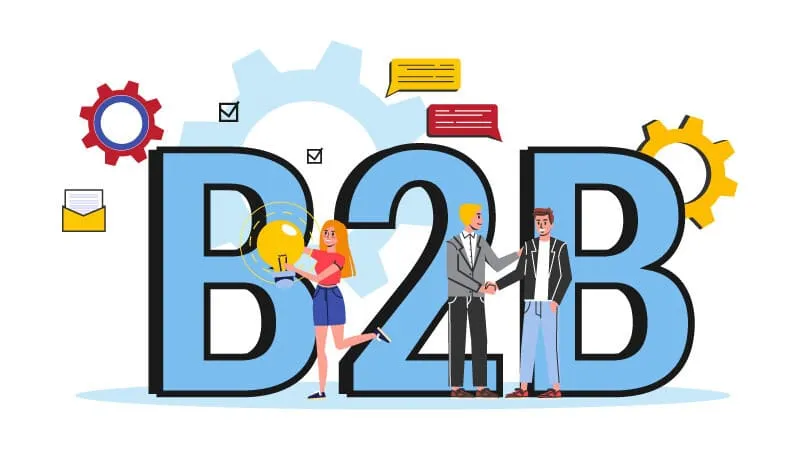What is B2B ? Understanding the B2B Model
In today's modern business world, B2B - Business-to-Business - is becoming an increasingly common model in Vietnam, especially for companies looking to scale up, establish long-term partnerships, and expand into international markets. But what exactly is B2B ? Where did it originate, and how is it applied ? This article will help you clearly understand the concept, origin, and practical applications of the B2B model - particularly for Small and Medium Enterprises (SMEs).

What is B2B ? Origins and the Evolution of the Business-to-Business Model
B2B refers to transactions where one business sells products or services to another business - not directly to consumers. This model is prevalent in industries such as manufacturing, exports, logistics, technology, and professional services.
The term “B2B” was first officially noted in a Gartner Group report in 1998, during the early boom of e-commerce, as companies began conducting transactions online. According to McKinsey & Company (2022), the global B2B market is five times larger than B2C, with rapid digital transformation - especially in industrial, import-export, and tech sectors.
In Vietnam, B2B initially grew popular in manufacturing and export - such as factories supplying raw materials to processing workshops. After the COVID-19 pandemic, this model expanded into services, cross-border e-commerce, and creative industries. Many SMEs also began realizing that B2B offers an efficient route to increase revenue, reduce retail dependency, and build more professional distribution channels.
Common Types of B2B Models Today
A food supplier in Dong Nai provides ingredients to local supermarket chains and simultaneously contracts a logistics firm to export goods to Europe. Each step is a B2B transaction - reflecting the true essence of the model. Here are some common B2B forms today:
- Manufacturing to Distribution: Businesses sell large quantities to distributors, agents, or retail chains.Example: A furniture company sells tables and chairs to supermarkets or showrooms.
- Professional Services: Fields like accounting, marketing, legal, design, or software - providing support for other businesses.Example: A startup outsources its branding and fanpage management to an external agency.
- Logistics and Supply Chain: From transport and warehousing to quality control, companies often work with specialized partners to fulfill large or export orders.
- B2B E-commerce: Vietnamese businesses sell directly to foreign companies through digital platforms - without relying on trade fairs, agents, or local offices.
- Integrated Ecosystems: A modern model where multiple stakeholders - suppliers, payment services, tech providers, and logistics - connect to create a seamless value chain.
How is B2B Different from B2C ?
A factory owner selling frozen mushrooms to a restaurant chain - that’s B2B. If that same person opens a shop selling small mushroom packs to individual customers - that’s B2C. Both involve selling, but the differences are clear:
- Target audience: B2B serves businesses that purchase for reuse or redistribution. B2C serves the end consumers.
- Decision-making process: B2B involves multiple approval steps, typically including the purchasing, finance, and technical departments. Meanwhile, B2C decisions are often driven by emotion or habit.
- Order value: B2B deals in contracts, high-value orders, and repeated purchases. B2C is usually small-scale, purchased based on immediate needs.
- Sales time and cycle: B2B sales cycles are longer, involving negotiations, sample testing, and contract signing. B2C is fast - often completed in just a few steps.
- Approach strategy: B2B requires building long-term relationships, providing technical documents and complete paperwork. B2C focuses on user experience and broad brand promotion.
How Can Small Businesses Tap into the B2B Model ?
Some believe B2B is only for big corporations - but that’s no longer true in the digital age. Small businesses can absolutely adopt B2B with the right mindset and tools.
- Be proactive in learning: Attend B2B seminars, read industry blogs, study business models, and learn how to create a professional business profile.
- Choose the right product and positioning: In B2B, you don’t need something “trendy” - it should be consistent, scalable, and process-driven. SMEs should focus on what they do best.
- Leverage digital platforms: There are many platforms today where SMEs can post products, find partners, and send quotations - without heavy upfront investment.
- Shift from "selling" to "relationship-building": B2B is not measured by daily orders but by the longevity of partnerships, contract scalability, and mutual trust.
Conclusion
B2B is no longer a complex model reserved for large corporations. Today, any business - from a small workshop to a young service firm - can enter the B2B space if they understand the fundamentals, prepare well, and choose the right tools.
What matters is not how big your team is or how much capital you have, but whether you’re willing to try, to learn, and to start from the simplest connections. In the B2B world, landing just one business client can take you much further than countless retail transactions.